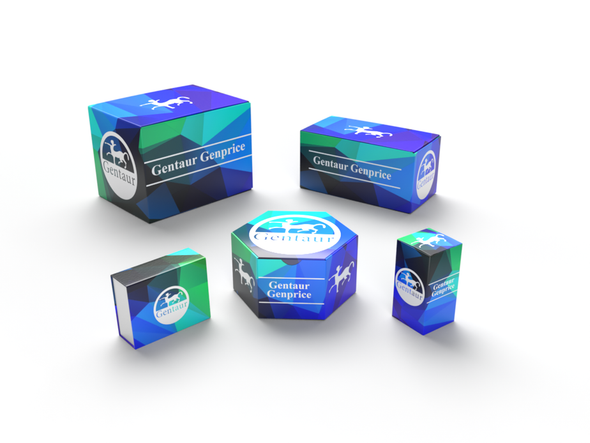Description
KLF4 Antibody | 5603 | Gentaur UK, US & Europe Distribution
Host: Rabbit
Reactivity: Human, Mouse, Rat
Homology: Predicted species reactivity based on immunogen sequence: Pig: (80%) , Bovine: (74%) , Chicken: (75%)
Immunogen: KLF4 antibody was raised against a 20 amino acid synthetic peptide near the carboxy terminus of human KLF4.
The immunogen is located within the last 50 amino acids of KLF4.
Research Area: Stem Cell
Tested Application: E, WB, IHC-P
Application: KLF4 antibody can be used for detection of KLF4 by Western blot at 1 - 2 μg/mL. Antibody can also be used for immunohistochemistry starting at 5 μg/mL.
Antibody validated: Western Blot in human samples and Immunohistochemistry in human samples. All other applications and species not yet tested.
Specificiy: N/A
Positive Control 1: Cat. No. 1304 - Human Liver Tissue Lysate
Positive Control 2: N/A
Positive Control 3: N/A
Positive Control 4: N/A
Positive Control 5: N/A
Positive Control 6: N/A
Molecular Weight: N/A
Validation: N/A
Isoform: N/A
Purification: KLF4 Antibody is affinity chromatography purified via peptide column.
Clonality: Polyclonal
Clone: N/A
Isotype: IgG
Conjugate: Unconjugated
Physical State: Liquid
Buffer: KLF4 Antibody is supplied in PBS containing 0.02% sodium azide.
Concentration: 1 mg/mL
Storage Condition: KLF4 antibody can be stored at 4˚C for three months and -20˚C, stable for up to one year. As with all antibodies care should be taken to avoid repeated freeze thaw cycles. Antibodies should not be exposed to prolonged high temperatures.
Alternate Name: KLF4 Antibody: EZF, GKLF, EZF, Krueppel-like factor 4, Epithelial zinc finger protein EZF
User Note: Optimal dilutions for each application to be determined by the researcher.
BACKGROUND: KLF4 Antibody: KLF4 is a transcription factor that functions as both a transcriptional activator and repressor to regulate proliferation and differentiation of multiple cell types. The role of KLF4 in embryonic development suggested that it might be useful in the creation of stem cells that might be useful in cell replacement therapies in the treatment of several degenerative diseases. Artificial stem cells, termed induced pluripotent stem (iPS) cells, can be created by expressing KLF4 and the transcription factors POU5F1, Sox2, and Lin28 along with c-Myc in mouse fibroblasts. More recently, experiments have demonstrated that iPS cells could be generated using expression plasmids expressing KLF4, Sox2, POU5F1 and c-Myc, eliminating the need for virus introduction, thereby addressing a safety concern for potential use of iPS cells in regenerative medicine. KLF4 interacts directly with POU5F1 and Sox2 in iPS and ES cells and activates the target gene NANOG.


![KLF4 Antibody [APR31980G] KLF4 Antibody [APR31980G]](https://cdn11.bigcommerce.com/s-1rdwiq712m/images/stencil/590x590/products/63123/63427/gentaur-genprice__26005.1661610467__29809.1661628092__75433.1661676199__77988.1661684280__64362.1661692443__14759.1661866244.png?c=1)
![KLF4 Antibody [AMM02487G] KLF4 Antibody [AMM02487G]](https://cdn11.bigcommerce.com/s-1rdwiq712m/images/stencil/590x590/products/54658/463830/gentaur-genprice__26005.1661610467__29809.1661628092__75433.1661676199__77988.1661684280__64362.1661692443__02085.1662049603__45075.1662119302__91744.1662191540__21580.1662291419__06590.1663322641.png?c=1)






![KLF4 Antibody [APR05060G] KLF4 Antibody [APR05060G]](https://cdn11.bigcommerce.com/s-1rdwiq712m/images/stencil/590x590/products/57647/57951/gentaur-genprice__26005.1661610467__29809.1661628092__75433.1661676199__77988.1661684280__64362.1661692443__86745.1661854269.png?c=1)